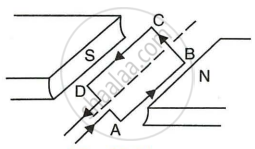Advertisements
Advertisements
प्रश्न
In the simple electric motor of figure given below, the coil rotates anticlockwise as seen by the eye from the position X when current flows in the coil

Is the current flowing clockwise or anticlockwise around the coil when viewed from above?
उत्तर
The current is flowing in clockwise direction around the coil when viewed from above.
Using Fleming's left-hand rule, the direction of current can be found.
APPEARS IN
संबंधित प्रश्न
What concealed do you get from the observation that a current-carrying wire deflects a compass needle placed near it?
Fill in the following blank with suitable words:
For a current-carrying solenoid, the magnetic field is like that of a ...........
State and explain the Clock face rule for determining the polarities of a circular wire carrying current.
The diagram given below represents magnetic field caused by a current-carrying conductor which is:

(a) a long straight wire
(b) a circular coil
(c) a solenoid
(d) a short straight wire
If the current in a wire is flowing in the vertically downward direction and a magnetic field is applied from west to east, what is the direction of force in the wire?
A coil ABCD mounted on an axle is placed between the poles N and S of a permanent magnet as shown in Figure.

- In which direction will the coil begin to rotate when current is passed through the coil in direction ABCD by connecting a battery at the ends A and D of the coil?
- Why is a commutator necessary for continuous rotation of the coil?
- Complete the diagram with commutator, etc. for the flow of current in the coil?
Name the following diagram and explain the concept behind it.

A current-carrying conductor of a certain length, kept perpendicular to the magnetic field experiences a force F. What will be the force if the current is increased four times, the length is halved and the magnetic field is tripled?
Assertion (A): A current carrying straight conductor experiences a force when placed perpendicular to the direction of magnetic field.
Reason (R): The net charge on a current carrying conductor is always zero.
